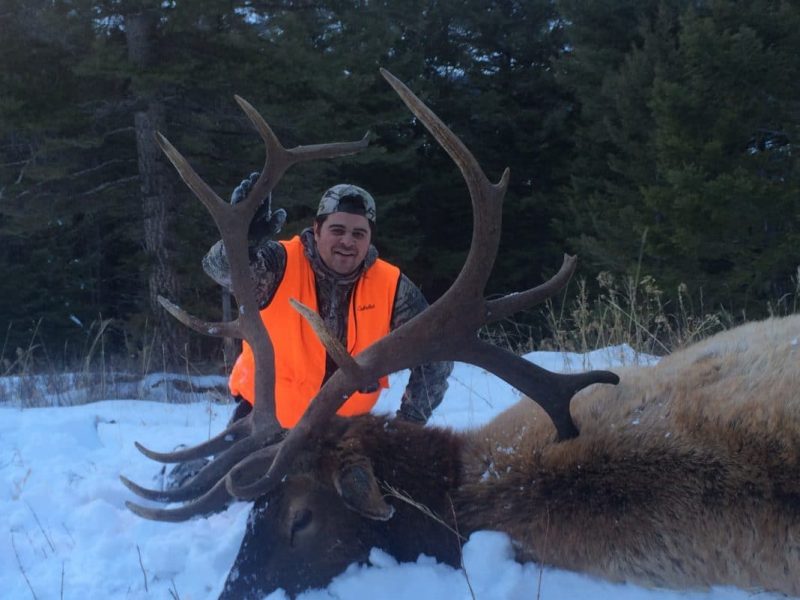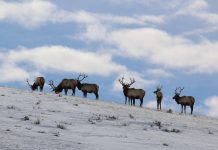
It is no secret that elk are smart, cunning, and elusive, so when you combine those three attributes it makes for difficult prey, even on a good day. With the addition of highly pressured and overly hunted elk, you have a next to impossible task. However, not all is lost. One can find opportunity within this chaos. Any elk hunter will tell you that the further off the road you go the better. Unfortunately, this isn’t possible for all of us. Some people just don’t have the time or resources to hunt deep country.
Alberta is a prime example of hunting high pressured elk. The elk in that area once lived in thick bush not accessible to humans, or high in the Rockies where only a few sheep hunters dare go. Since then the wolf and grizzly population has flourished pushing the elk out of the high timber and into the crown (public) land. Then with the oil boom came numerous lease roads giving everyone closer access to the elk. With easier access comes more hunters, and with more hunters comes more pressure. Below are a few tips and tricks to help you find success on your elk hunt despite this pressure.
Early season scouting
Most people don’t live in elk country, and for those who do, scouting does not always occur. A lot can change from year to year; consequently getting the jump on everyone early in the year is key. Humans are creatures of habit, and if they find success doing one thing they will keep doing it even though things can drastically change. Elk are similar, so if you can target a good bull early you will have a jump-start on the masses.
However, when you spot that bull early don’t over call him. It is no secret that every hunter loves the thundering sound of a bugle, but many times bugling can hurt your odds. Sometimes it seems like everyone has a bugle around their neck wondering why it isn’t easy like those they see in hunting shows. If you’ve been around elk long enough you know that they call all year. They do not necessarily bugle like they do in September year round but they do call.
I’ve killed a bull by following him and his harem while he called to another bull. I slipped in between him and his adversary and let them do the bugling while I slowly filtered through the bush to within shooting distance. The bull never knew I was there. I wanted to call and increase my odds but that would only alert the bull of my location. He might not necessarily have known I was a hunter, but he would have known something was there. If you do call, pay very close attention to the elk’s reaction and movement to your bull or cow calls. If your hunting highly pressured elk they have likely heard many bugles before, and elk don’t all have the same bugle. As I mentioned earlier, elk are smart and they learn quickly. If you repeat the exact same low to high bugle every time, your target bull will quickly register and leave.
Avoid the masses
I used to hunt an area where I was raised. Back then it was great and animals were everywhere. Once access to that area became easier more and more hunters poured in and eventually the area was overrun with weekend warriors. Once in a blue moon you’d be lucky enough to catch an elk, but they were so unresponsive and completely nocturnal; the place went dead. I completely left the area for some time but decided I would go during the week when most of the others were tied up with work. The area proved to be something completely different. It didn’t take long for the elk to realize Monday meant the hunters were gone.
That being said not everyone can take off work and hunt during the week. Therefore, another tip that has paid off big for me is to hunt all day. Most hunters appear at dusk and dawn, often returning home or to camp midday to nap, eat, and recover. The elk do the same, however, they’re camp is still in the bush. I’ve witnessed bugling battles between hunters and elk dwindle because 10:00 a.m. hit and it was time for breakfast. If your body and agenda permits, stay out all day. Pack some water and food to keep you going and find the elk during the day. Some of the best responses I’ve ever gotten from elk are when other hunters pack it in for the day. During this time slip in close to a herd and give off some light mews imitating a trailing cow. A bull might think during the fiasco he lost a cow and come running.
Go where other hunters won’t
As mentioned earlier, Alberta’s elk situation is pretty unique. I can be sitting in my deer stand and have a herd of 30 elk filter through towards an alfalfa field. A common misconception with the rookie elk hunter is that the rut starts September 1st and ends the 30th. If only it were that easy. Hunters in these easily accessible areas will ruin your chances at getting responses because the elk are already used to hunters calling. So, a very obvious tip is “ the further off the road and the harder the landscape, the fewer hunters you’ll encounter.” This is generally true, even with lease or logging roads.
My rule of thumb is, simply go where others will not. A lot of hunters want an elk but are not willing to work for it. Like any other prey, the harder it gets pushed the harder it will look for safety. This is why you don’t leave your tree stand when there’s several deer around you. The elk we’re talking about have been pushed and hunted hard already. Therefore, the deeper you can go and the further away from human interaction the better. That’s not to say that elk near access can’t be hunted, but the odds are not in your favor. Keep in mind elk live on the mountain 365 days a year so physically you are at a great disadvantage. Try and gain the upper hand by being in the best shape allowing yourself to access these hard to reach places.
Avoid the rut

Mario Vani
As mentioned earlier, everyone loves the rut and everyone loves the sound of an elk bugling at daybreak. Consequently, everyone hunts the rut. I hunt the rut as well, however, if my first trip proves unsuccessful I return to my elk hunting areas in early October or November. The difference is night and day. At this time the elk are no longer in herds and the bulls have tapered off living amongst themselves. The cows and smaller bulls usually stick together on lower, more accessible lands. If you are looking for a cow or young bull then this time is as good as any as they are seeking the richest food source before the winter hits.
If you’re after the trophy bull you’ll typically have to go high into the timber where the bulls hang out alone or with a few other bulls. This method has been very good to me. The snow, especially fresh snow, allows you to follow the elk and know their patterns. With the snow, the hunters that might have tempted the hills back in September are turned away by the increased challenge of battling the bitter late-season temperatures. Fewer hunters will be hiking and camping at this time. However, if you come prepared this can be some of the most rewarding elk hunting.
I used this method last year in Montana. We started at the bottom of the hills where the odd hunter would be parked in his truck or walking the field edge. Here you saw hundreds of cows and some spikes but no shooters. Then as we zigzagged up the hills the snow became deeper, but the tracks were bigger. So we followed these fresh tracks where no human had walked slowly cresting hill after hill in hopes of catching up to the big herd bull. Eventually, we found the unpressured bull feeding in an open meadow 150 yards from us without a worry in the world.














